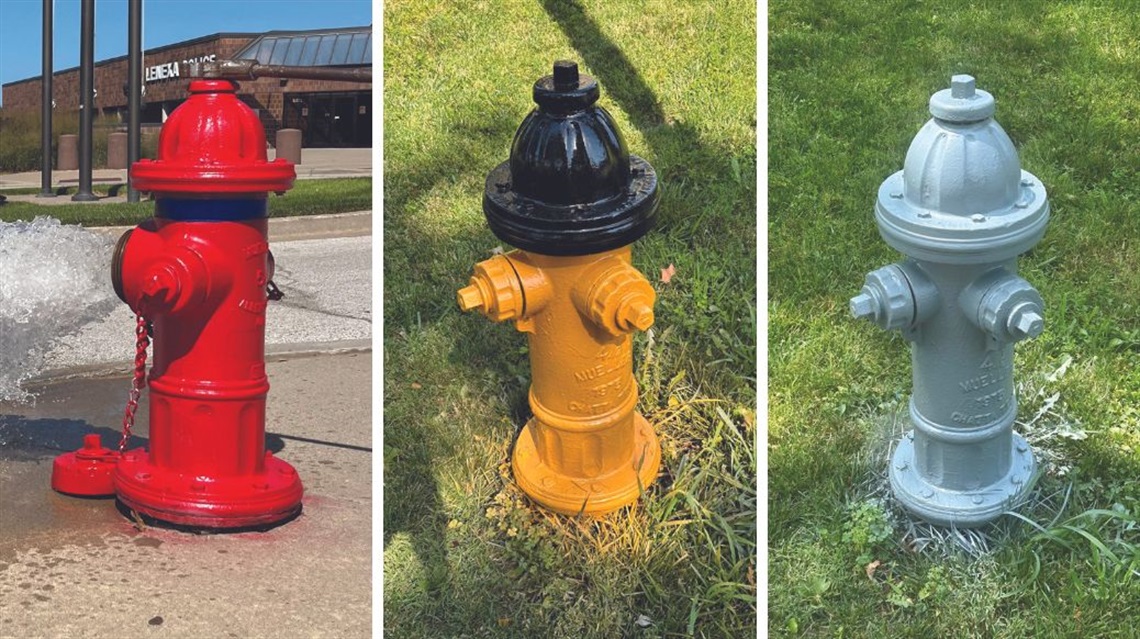Fire hydrants 101
Published on July 08, 2024

Next time you’re driving through Lenexa, look around and count how many fire hydrants you see. There are probably a lot more than you think. Lenexa has more than 3,300 hydrants! You may wonder why they are different colors. Or why do the red ones have colored bands on them? In the summer, you may even see a gray one.
Why are there so many fire hydrants?
The Lenexa Fire Department’s ability to quickly put out a fire and prevent a fire from spreading to neighboring structures is heavily dependent on access to water. Most fire trucks hold between 500 and 1,000 gallons of water, but a building fire could take 10,000 to 100,000+ gallons of water to extinguish. The average fire hydrant, however, can pump 1,000 gallons of water per minute, ensuring emergency crews have reliable access to the water they need.
The adopted fire code has changed over time. The current fire code requires more hydrants than in the past to ensure adequate fire flow coverage for a building. This is why you will see more hydrants in newly developed areas of Lenexa.
Why are fire hydrants different colors?
There are two types of fire hydrants in Lenexa: public and private. Public hydrants are painted yellow and black. They are installed and maintained by WaterOne. The hydrants found in residential areas are primarily public hydrants. They are also found throughout the city.
Private hydrants are painted red. They are installed and maintained by the property owners. These hydrants are primarily found on commercial properties. They are required by the City to be installed during construction to ensure an adequate water supply in case of a fire at the property. Private hydrants are still available for use on a neighboring property in an emergency, but the maintenance of the hydrant is the responsibility of the property owner.
What kind of maintenance does a fire hydrant require?
Hydrants are required by the fire code to be visually inspected and flowed annually. This ensures there are no leaks or damage, and the hydrant is properly maintained and painted. Flowing a hydrant by opening it confirms the hydrant works and clears sediment and stagnant water from the line.
Every year during the summer, WaterOne conducts a hydrant audit and performs regular maintenance per the American Water Works Association standards. Their interns inspect and flow all public hydrants and will repaint hydrants when necessary. When they repaint a hydrant, they apply a gray primer coat and a few days later they paint it the typical yellow and black colors.
Every five years a hydrant capacity flow test is required. This test will provide the number of gallons per minute (gpm) at 20 pounds per square inch (psi) which determines the band color on a private hydrant. This allows emergency crews to quickly identify how much water is expected from a particular hydrant.
Understanding the colored bands
- 1,500 gpm or greater (Class AA) — Blue
- 1,000–1,499 gpm (Class A) — Green
- 500–999 gpm (Class B) — Orange
- Less than 500 gpm (Class C) — Red
The Lenexa Fire Department conducts annual inspections of businesses in the city. As part of these inspections, they verify that privately owned hydrants have had the appropriate inspections and maintenance performed.
How can you help us maintain quick access to fire hydrants?
Park at least 15 feet — about one car length — away from a hydrant. Blocking a hydrant with your car could prevent access in an emergency and cause damage to your car when crews attempt to access the hydrant.
Keep at least 36 inches clear around a hydrant on your property. This includes tall grass or weeds and snow during the winter.
Leave hydrants alone. Don’t open, paint or vandalize hydrants.
If something looks wrong with a hydrant, report it. Call WaterOne (913.895.1800) for public (yellow hydrants) and the Lenexa Fire Department (913.477.7990) for private (red hydrants).
Did you know?
Water used during an emergency response is not billed to the property owner or the fire department. If the hydrant is used for another purpose, a hydrant meter must be obtained from WaterOne to track usage for billing purposes.